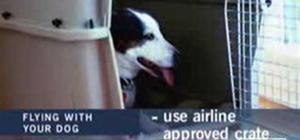Tips
If you are taking a relatively uncomplicated flight to post, it may be to your advantage to take your pet along as excess baggage. Ask the travel agent to provide you with a cost comparison of excess baggage versus air freight shipment.(Remember also to save your receipts for shipment as a legitimate "moving expense" for the IRS.)
Reserve air space for shipment as early as possible. Be sure to schedule arrival on a weekday and not a weekend, as it is usually necessary for animals to be cleared by a veterinarian upon arrival.
Alert the post in advance of flight and particulars, as it will often help speed the processing. Also, the post will then arrange temporary housing that allows pets.
Provide a sturdy, leak-proof crate (lined with absorbent material such as newspaper) that is large enough for the animal to stand, lie down, or turn around in, but not so large that the animal would be battered around in rough weather. Most U.S. carriers have shipping containers in various sizes available for purchase. However, shop early as they may not have all sizes in stock at the particular time you need one. (Once again, this is a moving expense; save the receipt.)
- Let your pet become accustomed to the crate before shipment by having practice sessions that build in time of confinement. Be sure the pet has a comfortable pad to lie on and a few familiar toys. A leash should also be included with the crate.
- Put identification tags that include an emergency phone number around your pet's neck.
- Print your name and destination address clearly on the shipping crate itself. Include your pet's name, so that attendants can talk with him/her. If the pet has special habits--or bites--also include that information. You might want to list this information in other languages, depending on the countries transited.
- Carry a photo of your pet with you.
- Feed your pet just a light meal about six hours before shipping--no water within two hours unless it is very hot (or the animal is very small). A water dish that is attached so it cannot tip should be provided, but it should be conveniently located to allow an attendant to provide water at stopovers without being bitten.
- Send dry food along if the trip is long. If you send canned food, fasten an opener and dish to the crate in a cloth or mesh bag with feeding instructions clearly marked on the crate.
- Do not tranquilize the animal without your veterinarian's approval.
- Exercise your pet just before shipping so your animal will sleep better during the trip.
- Check with the agent who meets the flight about your pet's progress when you are changing planes. Have your airway bill number readily available when doing this.
- Allow plenty of time between connecting flights to be sure your animal is transferred to your flight if traveling with you.
- If there is a delay, the airline will kennel the pets when kennels are available. State on your airway bill that your animal is to be taken to the animal port if there is a delay or stopover, if you desire the service.
- Arrange to have your pet picked up immediately upon arrival. Airline facilities for pets may be limited or nonexistent.
Just updated your iPhone? You'll find new emoji, enhanced security, podcast transcripts, Apple Cash virtual numbers, and other useful features. There are even new additions hidden within Safari. Find out what's new and changed on your iPhone with the iOS 17.4 update.







Be the First to Comment
Share Your Thoughts